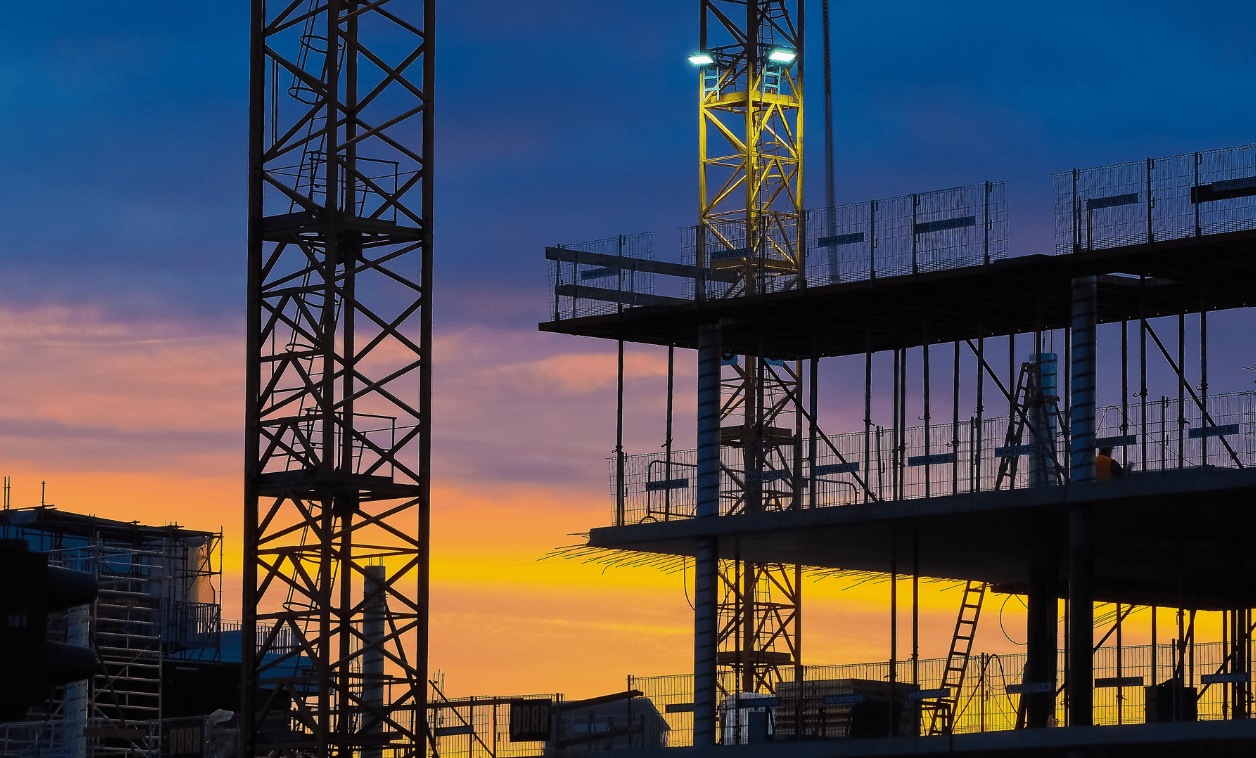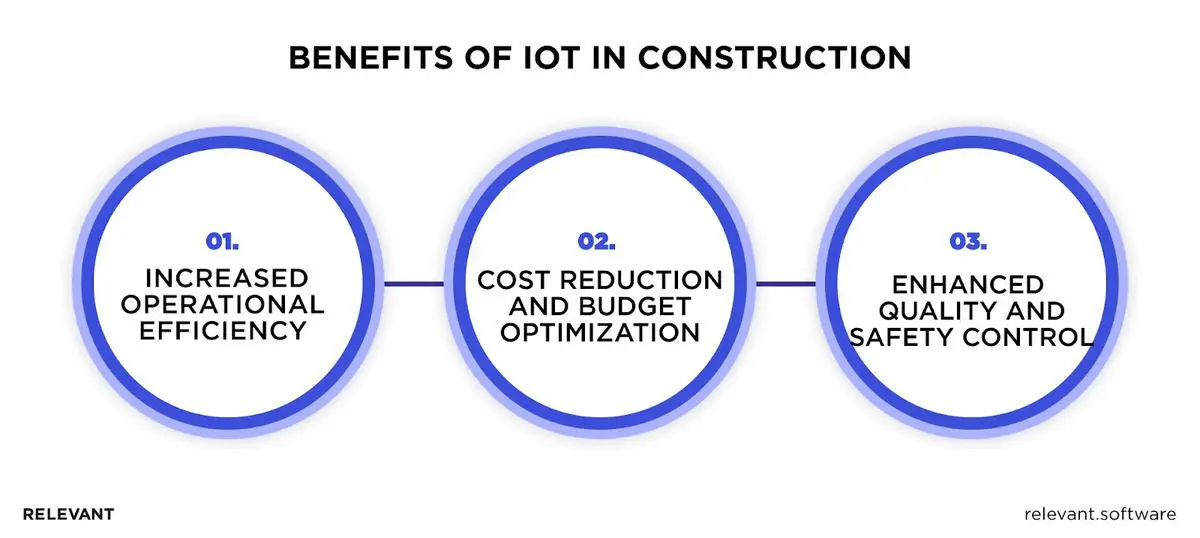IoT in Construction: Invest in the Industry 4.0 Future

At first glance, the idea of infusing IoT in construction industry might appear contradictory. After all, with its rugged work boots, concrete, and cranes, construction feels worlds away from the IoT with its intelligent devices and cloud computing. Howbeit, this fusion of physical and digital is quietly transforming the construction industry.
Consider the daily routine on a construction site: workers coordinate tasks, machinery moves heavy materials, and project managers monitor progress. Now, inject some IoT into this picture. Suddenly, those heavy machines are smart enough to report their own maintenance needs; drones are mapping the site in real time, and wearable devices ensure worker safety by monitoring vital signs and sending alerts if accidents occur. It sounds futuristic, yet it’s our current reality. The construction industry has already made investments in IoT, totaling around $14 billion globally, marking it as a very promising market.
So, what is IoT in construction? We will describe this innovation currently manifesting as “Industry 4.0” and focus on prospects of IoT development for the construction industry.
IoT in Construction: Definition and Components
At its core, IoT in construction industry offers a smarter, more connected way to manage the complexities of building. By embedding IoT sensors in construction equipment and materials, data flows continuously, allowing instant tracking of construction sites, machinery, and workers. But what are the real implications for the industry?

Firstly, IoT means enhanced safety, as supervisors can instantly be alerted to workers’ and machinery’s movements and conditions. Secondarily, technology implies effectiveness, with the ability to track materials to the exact location and moment needed, minimizing waste and waiting times. Thirdly, IoT implementation guarantees the next level in quality due to data analysis to improve practices, anticipate problems, and ensure that every project element meets the highest standards.
As a result, construction sites are becoming smart environments, leading to a more fluid, interconnected, and technologically driven strategy for building the infrastructure of tomorrow.
We create a detailed table outlining the components of IoT in construction market:
| Component | Role/Function in Construction | Examples of Applications |
| Sensors and wearables | Gather instant data on different measures such as temperature, humidity, pressure, and others throughout the construction site. | Monitoring environmental conditions, tracking the structural health of buildings |
| Actuators | Perform physical actions based on the data or commands received, often automatically or remotely. | Controlling HVAC systems, operating machinery |
| Connectivity | Provide the network connections to ensure communication between devices and the central system. | Wi-Fi, Cellular Networks, LoRaWAN for site-wide connectivity |
| Data Processing Units | Analyze and process the data collected from sensors to make decisions or trigger actions. | Edge computing devices for real-time data analysis |
| User Interface (UI) | Facilitate interaction between the management team and the IoT system for monitoring and control. | Dashboards on tablets or smartphones, web interfaces |
| Security Systems | Protect IoT devices and the data they handle from unauthorized access and cyber threats. | Encryption, secure VPNs for data transmission |
| Device Management Tools | Allow for the remote management, configuration, testing, and troubleshooting of IoT devices across the construction site. | Software platforms for device firmware updates and status monitoring |
| Integration Software | Facilitate the seamless integration of IoT devices with existing construction management software and systems. | Middleware for connecting IoT data with project management tools |
| Power Supply | Ensure a reliable and continuous power source for IoT devices, especially in remote or power-scarce areas. | Solar panels, battery packs |
| Data Storage Solutions | Store the vast amounts of data generated by IoT devices for analysis, reporting, and future reference. | Cloud storage services, on-site servers |
All these components together create an interconnected environment that optimizes construction companies’ operations and achieves greater efficiency, safety, and productivity.
What you’ll read next – IoT Architecture Introduction
Benefits of IoT in Construction Sector
Initially, the sector relied heavily on manual tasks and compartmentalized data handling, often resulting in operational bottlenecks and project setbacks. However, with the progression of IoT technology and its adoption, we’ve seen such benefits of IoT in construction, like:

1. Increased Operational Efficiency
Project managers can efficiently monitor equipment usage and performance by utilizing interconnected sensors and devices and making immediate adjustments to prevent downtime. This real-time communication reduces the need for manual oversight and ensures the project runs smoothly without unnecessary interruptions.
Automated IoT systems handle routine operations like inventory control and report generation, freeing up human talent for more critical strategic work. With the Internet of Things, information is easily shared among all stakeholders, from field workers to project managers, allowing faster and more informed decisions to be made based on evidence rather than assumptions.
IoT in construction case study indicates that companies implementing IoT solutions for resource management increase productivity by 14% and improve equipment efficiency by 30%.
Your next read – How to Build an IoT Dashboard
2. Cost Reduction and Budget Optimization
Construction projects often walk a tightrope between budget time and quality. McKinsey reports that 98% of them suffer from cost overruns or delays and that the average slippage is 20 months behind schedule.
Yet, IoT in construction helps you maintain that balance by tracking the precise location and utilization of materials and equipment, eliminating waste and unnecessary costs. Sensors detect potential issues in equipment before they become costly breakdowns. Additionally, construction IoT helps schedule preventative maintenance optimally, minimizing downtime and repair costs.
Industry numbers show that when construction firms start using IoT technology, they experience a 30% decrease in energy consumption, and their project expenses drop by 12%.
3. Enhanced Quality and Safety Control
Construction sites can be dangerous, but IoT technology can change that narrative. One of the IoT tasks is creating a safer work environment. Equipping workers with IoT devices such as portable sensors, smartphones with GPS, and RFID tags simplifies monitoring of vital signs and tracking work hours.
And it’s not just about avoiding accidents. Sensors monitor environmental conditions, material properties, and construction processes, providing continuous feedback on quality.
Moreover, IoT used in construction helps ensure projects comply with safety regulations, automatically documenting procedures and conditions to keep everything up to code. Data collected through sensors creates a digital record of the construction process, providing invaluable evidence for quality control and future projects.
Studies show that construction companies that embrace IoT for safety management experience a 25% reduction in accidents and a 19% drop in workplace injuries.
Applications of IoT in Construction Industry
The construction world is undergoing a serious technological upgrade thanks to the Internet of Things. It’s changing the game in a big way, making old-school construction methods look like something out of history books. Below are some examples of possible IoT applications in construction industry, and their amount continues to grow.
| Application | Description | Benefits |
| Site Safety and Security | IoT devices monitor real-time site conditions, tracking worker movements and environmental hazards like gas leaks or extreme weather while also enhancing site security against unauthorized access. | Improving adherence to safety protocols, reducing accident risk, and securing the site. |
| Asset and Equipment Tracking | Real-time monitoring of the location, status, and utilization of machinery and materials using IoT technology. | Preventing theft, optimizing equipment use, and ensuring maintenance are conducted timely. |
| Resource Management | IoT sensors manage the consumption of resources such as energy and water efficiently, aiming to minimize waste. | Identifying cost-saving opportunities and promoting sustainability. |
| Monitoring Site Activities | Sensors and cameras provide insights into construction progress, worker productivity, and equipment use. | Enabling informed decision-making and identifying process bottlenecks. |
| Supply Chain Management | IoT enhances supply chain visibility, monitoring inventory levels and automating material reordering processes. | Ensuring resource availability, minimizing project delays. |
| Concrete Curing Optimization | Embedding IoT sensors in concrete to monitor curing, providing data on strength and readiness for subsequent construction phases. | Ensuring structural integrity and optimizing construction scheduling. |
| Waste Management | Sensors track waste levels, facilitating efficient disposal and management practices. | Enhancing site cleanliness, complying with regulations, and reducing environmental impact. |
| Structural Health Monitoring | Deploying sensors to detect vibrations, cracks, and other structural health indicators in buildings and infrastructure. | Allowing for early maintenance interventions, ensuring longevity and safety. |
| Drone Site Inspection | Employing drones for aerial site inspections to assist in planning, progress tracking, and safety assessments. | Offering comprehensive site overviews, enhancing planning accuracy, and improving safety. |
| Data Analytics and Predictive Maintenance | Analyzing data from IoT devices for predictive maintenance and process optimization in construction. | Reducing equipment downtime and extending the life of construction assets. |
| Information Modeling (BIM) Integration | BIM provides detailed digital representations of buildings | Helping adjust plans due to a discrepancy between the model and the actual construction and ensuring projects are completed as efficiently as possible |
The market’s total value driving the IoT in the construction industry is expected to hit $26,79 billion by 2028. According to the Global Construction Survey, over 70% of construction providers worldwide consider implementing this and other advanced technologies as a prerequisite for future growth.
How to Build an IoT Construction Platform
Building an IoT for construction is no small feat, but the potential benefits are undeniable: increased efficiency, cost savings, and improved quality control. Let’s explore the key steps involved in developing a platform that truly serves the unique needs of the construction industry.

Understanding the Specific Needs of Construction Projects
First off, knowing what your construction project specifically needs from IoT is key. Every project is different—building a bridge isn’t the same as erecting a skyscraper or building a housing complex. Each comes with its own set of challenges and data requirements. You’ve got to think about the location’s challenges, like how remote or harsh it is, who’s involved, from the engineers to the end clients, and what they all need from the data you collect.
Designing an IoT Construction Platform
When it’s time to design your IoT construction platform, there are a few big things to keep in mind. The user interface has to be simple and easy to use, even in the middle of a hectic construction site. Then, decide on the platform’s main tasks— be it collecting data, monitoring in real-time, and maybe even predicting maintenance needs. Also, consider how the platform can be scaled to be always suited to the project size.
Selecting the Right Sensors and Devices
Choosing the right tools for the job is crucial. Sensors and devices will gather the specific kinds of data your project needs, like temperature or pressure, and they’ve got to be tough enough to handle a construction site’s rough conditions. They also must fit with whatever power sources and communication methods you have available, whether Wi-Fi, cellular, or something else.
Data Management and Analytics
Having lots of data is great, but only if you know what to do with it. Effective data management means storing it securely and analyzing it in ways that let you make smarter decisions and keep the project moving smoothly. Whether spotting a potential issue before it becomes a big problem or ensuring everything’s running as efficiently as possible, the right data strategy is essential.
Integration with Existing Systems
Finally, your new IoT solution must be integrated with any existing systems you use for construction management. This might mean some custom work to ensure everything communicates properly and shares data without any hitches. The goal is a seamless operation where the IoT platform enhances the tools you already trust, making the whole project run smoother.
Note. We at Relevant have created a comprehensive IoT platform for Sensor Innovation, enabling easy management of sensors, encompassing real-time data tracking and notifications. You can view this case study here.
IoT in Construction: Final Thoughts
Although IoT application in construction industry isn’t always in the spotlight, its contribution is evidently impactful. It means leveraging technology to build not just faster or cheaper but smarter. By streamlining operations, optimizing costs, and enhancing quality control, IoT and construction are creating a future where projects are more efficient, cost-effective, and successful.
What is the next step? Hiring IoT developers in Relevant – a global software development company, of course. It is the smartest play for those looking to implement IoT in construction business. By addressing the specific needs of construction projects, designing a user-friendly and scalable platform, choosing the right tools, and effectively managing data, we can transform your construction projects for the better.



